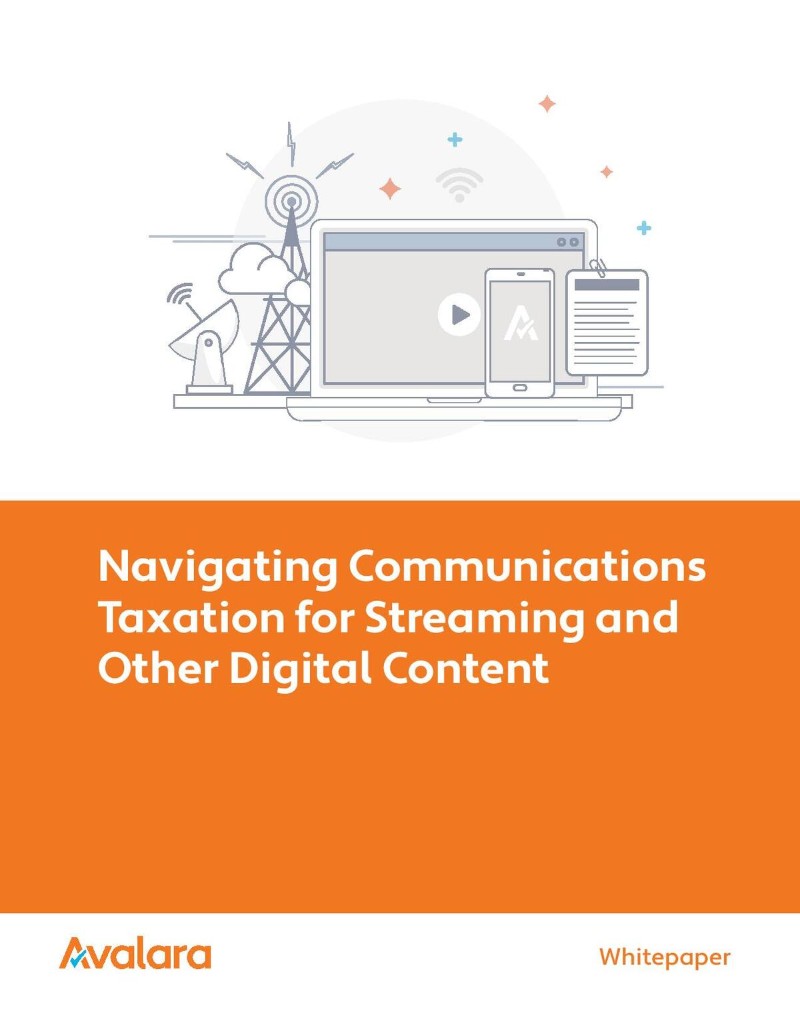Taxation for Streaming & Digital Content
Published on 11 Feb 2021

Navigating Communications Taxation for Streaming and Other Digital Content
Where there’s a will, there’s a way — for consumers to go without pay TV, that is. Or traditional AM/FM radio, or movie theaters, or once-ubiquitous CD players that used to come installed in cars. Even live sporting events and concerts can be enjoyed virtually anywhere, on any device. If it can be watched or listened to, it can be streamed. And if it can be streamed, there’s a good chance communications tax might be applicable. As the communications industry continues to innovate and grow into new spaces, the possibility of communicationsspecific taxation at the local, state, and federal levels becomes increasingly likely to apply to those areas. There are many indications that a highly complex array of liabilities is forming one that stands to have massive implications for tax teams at companies that give consumers options for streaming TV, movies, music, and more.
Does communications taxation need to be on your radar?
Traditional communications taxation is rapidly evolving to encapsulate a much wider range of services. For the company that hasn’t yet had to contend with these regulations and fees, it could very well be a matter of time. That means a company accustomed to calculating sales and use tax alone may soon find itself facing a far more complex array of taxes and regulatory fees. This is likely to apply in varied ways in many jurisdictions if you offer: • Digital content including video, audio, games, or software • Content via delivery mechanisms such as live or on-demand streaming OR digital download And, if you’re a wireless, cable, or satellite company and you begin offering these services after a merger or acquisition, or through a partnership as part of a bundle, you should be ready for the likelihood of additional tax complexities for those services as well. Even the slightest indicator that you could be responsible for calculating and remitting communications taxes on these services, either now or in the future, is a sign that you need an action plan now. Being caught unaware is a costly mistake. This whitepaper will give you guidance to know when you’re entering the realm of communications taxation, and steps you should take to prepare.
The rise of digital content
While the delivery of digital content isn’t all that new — Netflix launched its streaming video service in 2007 — it’s been in recent years that demand has skyrocketed, particularly for streaming content. But what, exactly, is driving this change? For consumers, broadband is now in more than 80 percent of homes and high-quality audio and video are easier than ever to access. The increased availability of streaming subscriptions and virtual multichannel video programming distributors (vMVPDs) has led many households to view traditional pay-TV bundles as bloated or overpriced. Nearly 60 percent of Americans have adopted some form of streaming service, and 20 percent have made the move to streaming only. Whether it’s to cut the cord completely or simply expand viewing and listening options, America’s appetite for streaming content is voracious. Consumers spend $2.1 billion a month on streaming video, a number that continues to climb, and want even more content from providers.
As people replace DVDs, downloads, and other digital goods with digital services, it’s not just pay-TV providers that are being impacted. By the first half of 2017, streaming subscriptions accounted for 62 percent of music market revenue and fueled the industry’s first double-digit growth in nearly two decades, moves that led retailers to start pulling the plug on selling CDs. For businesses, fierce competition has led to a vast array of new offerings, particularly as M&A activity has increased. Content providers continue to launch their own streaming services with unique pricing models, cannibalizing major content platforms and providers as partners become competitors. Meanwhile, wireless, cable, and streaming subscriptions are constantly coming together in new and innovative ways as companies battle to serve up the “best” or “most popular” options in an incredibly tight market. Cable providers are leveraging “skinny bundles” to combat direct-to-consumer streaming content companies, while unique voice, data, and video bundles with “unlimited” or “inclusive” models sweeten wireless packages. A particularly defining moment for the industry occurred when Disney, including its ESPN brand, announced it would be pulling content from Netflix to start its own standalone streaming service.
Download Avalara's whitepaper to understand the image of tax regulations for digital content and streaming services. For more finance whitepapers on tax regulations and other areas, subscribe to Whitepapers.online.
